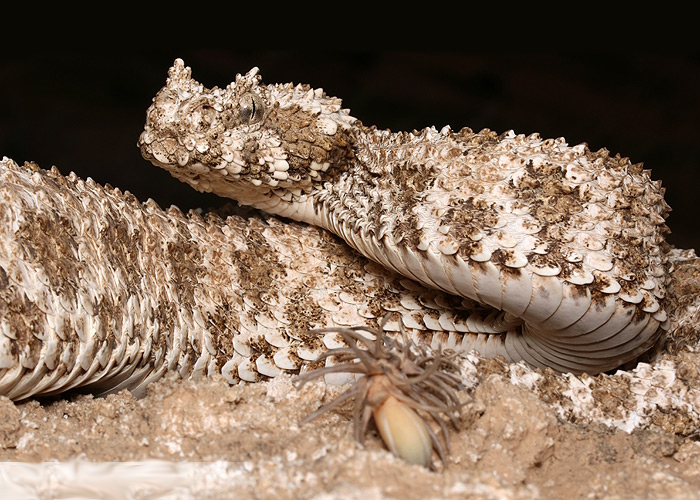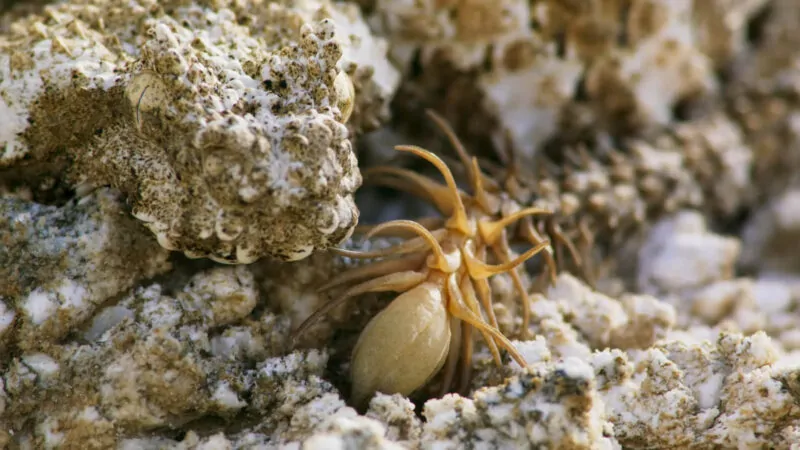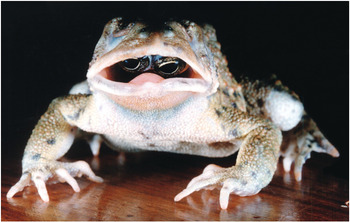In the sun-scorched deserts of western Iran, a creature slithers silently through the sand, almost invisible to the untrained eye. Its body is rough and textured, blending perfectly with the rocky terrain. At first glance, it appears to be just another snake—until you notice its tail.
A closer look reveals something astonishing. The tip of its tail isn’t shaped like a typical rattle or a simple taper—it looks like a spider. Legs and all. And it doesn’t just sit there. The snake moves it. It wiggles the fake spider in a disturbingly lifelike way, creating the illusion of a real arachnid crawling across the ground.
This is the Spider-Tailed Horned Viper (Pseudocerastes urarachnoides), and it has one of the most jaw-dropping evolutionary adaptations in the animal kingdom.
This strange tail isn’t just for show—it’s bait. The viper uses it to lure in birds, especially small insectivorous or omnivorous species who see what they think is an easy meal. As the bird swoops in for the spider, the snake strikes with lethal precision.
It’s a tactic called “aggressive mimicry,” where a predator imitates something harmless or appealing to its prey. And in this case, the deception is so effective that many birds don’t realize what’s happening until it’s far too late.
This strategy is rare in snakes. While many species rely on camouflage or venom, the Spider-Tailed Viper goes one step further—using illusion as a hunting tool. It’s a level of behavioral complexity that seems almost too clever to be real.
The viper’s natural habitat is dry, rocky, and unforgiving. It thrives in areas with little vegetation, where blending into the landscape is essential for both hunting and protection. Its coloration—dusty browns and faded grays—makes it nearly invisible against the desert floor.
Add the tail lure, and the snake becomes a living trap, perfectly designed for ambush. It lies motionless for hours, sometimes longer, waiting for the right moment. When the wind is calm and the prey is near, the tail begins to twitch. Slowly. Precisely.
To the watching bird, there’s no threat. Just lunch.
Until it’s not.
The Spider-Tailed Horned Viper was only officially recognized as a species in 2006, although locals had known of its existence for much longer. It remains elusive in the wild, and scientists are still learning about its behavior, distribution, and evolutionary history.
Its unique tail structure—complete with fleshy “legs”—has no known equivalent in the snake world. It’s not just the look, but the motion that completes the illusion. And since this viper lives in such remote areas, detailed observation is limited. Much of its life is still a mystery.
What makes the Spider-Tailed Horned Viper so captivating isn’t just the horror-movie strangeness of its appearance, but the subtle genius of its design. This creature didn’t evolve strength, speed, or size—it evolved deception. It turned its body into a puppet theater and taught itself how to lie.
And in doing so, it became a master hunter in one of the harshest environments on Earth.
It’s a humbling reminder that nature doesn’t always follow the rules we expect. Sometimes, the most astonishing solutions come from the strangest corners of the world. A snake with a spider for a tail? That sounds impossible—until it isn’t.
So the next time you’re marveling at the wonders of evolution, remember: somewhere in the Iranian desert, a snake is putting on a show. And for one unlucky bird, it’s the final act.







